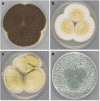Safety of the fungal workhorses of industrial biotechnology: update on the mycotoxin and secondary metabolite potential of Aspergillus niger, Aspergillus oryzae, and Trichoderma reesei
- PMID: 30293194
- PMCID: PMC6208954
- DOI: 10.1007/s00253-018-9354-1
Safety of the fungal workhorses of industrial biotechnology: update on the mycotoxin and secondary metabolite potential of Aspergillus niger, Aspergillus oryzae, and Trichoderma reesei
Abstract
This review presents an update on the current knowledge of the secondary metabolite potential of the major fungal species used in industrial biotechnology, i.e., Aspergillus niger, Aspergillus oryzae, and Trichoderma reesei. These species have a long history of safe use for enzyme production. Like most microorganisms that exist in a challenging environment in nature, these fungi can produce a large variety and number of secondary metabolites. Many of these compounds present several properties that make them attractive for different industrial and medical applications. A description of all known secondary metabolites produced by these species is presented here. Mycotoxins are a very limited group of secondary metabolites that can be produced by fungi and that pose health hazards in humans and other vertebrates when ingested in small amounts. Some mycotoxins are species-specific. Here, we present scientific basis for (1) the definition of mycotoxins including an update on their toxicity and (2) the clarity on misclassification of species and their mycotoxin potential reported in literature, e.g., A. oryzae has been wrongly reported as an aflatoxin producer, due to misclassification of Aspergillus flavus strains. It is therefore of paramount importance to accurately describe the mycotoxins that can potentially be produced by a fungal species that is to be used as a production organism and to ensure that production strains are not capable of producing mycotoxins during enzyme production. This review is intended as a reference paper for authorities, companies, and researchers dealing with secondary metabolite assessment, risk evaluation for food or feed enzyme production, or considerations on the use of these species as production hosts.
Keywords: Industrial enzymes; Mycotoxins; Safety; Secondary metabolites.
Conflict of interest statement
Conflict of interest
The authors declare that they have no conflict of interest.
Ethical approval
This article does not contain any studies with human participants or animals performed by any of the authors.
Figures


References
-
- Abdelghany TM, El-Nagger MA, Ganash MA, Al Abboud MA. PCR identification of Aspergillus niger with using natural additives for controlling and detection of malformins and maltoryzine production by HPLC. BioNanoSci. 2017;7:588–596. doi: 10.1007/s12668-017-0455-6. - DOI
-
- Abe S, Saito T, Takayama KI, Furuya A (1961) L-Malic acid by fermentation. British patent no. 884,029, December 6
Publication types
MeSH terms
Substances
LinkOut - more resources
Full Text Sources

